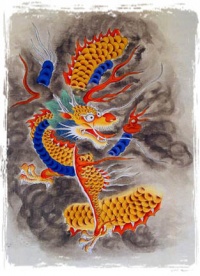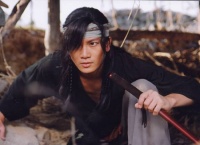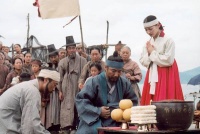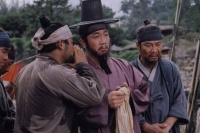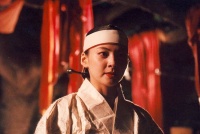Dragons of the Yellow Sea
Contents
Dragons of the Yellow Sea
The players will be humans and dragons who are part of the peasant rebellion in Korea, on Jeju island at the southern tip of the peninsula. We will play at least 2 characters each. The game world is loosely based on Naomi Novik's Temeraire series of novels and its alternate history; His Majesty's Dragon, Throne of Jade, and Black Powder War.
General thoughts on game flavor:
- In the Temeraire series, Lawrence is a ship captain, not of a tiny ship, but he is also not an admiral; he's of medium importance. However, he has enormous importance in the world story. His dragon turns out to be one of only a handful of Celestial dragons; he saves England, is adopted by the Emperor of China, and so forth.
- Also taking a note from the movie Blood Rain, the characters will be similarly larger-than-life.
- The game will have long episodes which tell the story of how characters become important.
To reflect this, we will be using a variant of the pulp action RPG, Spirit of the Century.
Characters
Character ideas
- Madeline - leans towards playing an outsider, maybe a Mongol Han Solo.
- Madeline - Japanese spy
- Bill - Yong Gi Ja, a Jade Dragon, retired from government courier service.
- Bill - Kim Cho Hea, Park Min Bai's niece, a pearl diver.
- Cyn -Park Min Bai, a shaman from Jeju-do.
- Cyn - Bob's character's hatchling dragon. fire breathing. Perky and bouncy.
- Lee - Lee Ho-Fook. 40-ish related to Bob's character. Bitter fisherman. back from foreign lands after absence of 20 years.
- Lee - Catholic priest?
- Liz - Min Ju. Surly teenager. Used to be called "Snotface" and is now called "The Rat". He grew up on the streets, he's a petty criminal, and does odd jobs around town. His mom is a disreputable, abusive drunk.
- Liz - Yong Dak-Ho, Lee's fisher dragon with leanings towards amateur naturalist/science. Dak-Ho has a collection of cool ocean stuff as her dragon bling. modern/japanese sympathies.
- Bob - Inheriting the Orange/Citrus farm (the island's traditional tribute to Seoul)
- Bob - Heather's fire breathing dragon.
- Heather - A Chinese warrior who deserted during (after? not sure) the Taiping Rebellion and later fled with her dragon across the sea to Jeju-do.
- Heather - A feral dragon native to Jeju-do.
- GM: John Kim
If we follow the conventions of dragon naming in Novik's China, Chinese dragons would have three-part names starting with "Lung" (meaning "dragon"). Korean dragon names would start with "Yong" if we construct them the same way. Dragon geneologies may become important. For human names, here's an article on Korean names. Here is a good table with some Korean name elements and their meanings. Names "in translation" should be fine too.
NPCs
- family members. We will need some geneological charts. Many human characters may be part of two main families of Seongsan. Dragon families should be developed as well, though they might be sparser and more scattered.
- Chul-Sun. "Sarge". A big hulking military battle veteran/ex bandit/secret military genius/sergeant who became a farmer and swore never to pick up another sword
- The older smuggler captain
- The local magistrate (somewhat corrupt, in the smuggler captain's pocket)
- Must make up yangban family or families
- Teacher (dragon) at the village fisher dragon school
Historical Background
Korea in the 1860s was at a turning point. China had been humiliated by the European powers in the Opium Wars (1834-43 and 1856-60), and was still in the throes of the Taiping Rebellion (1851-65). Meanwhile, Japan had just been forced into the Convention of Kanagawa by Admiral Perry's "Black Ships" (1854), but was just beginning its modernization -- the Meiji Restoration would start in 1866. Within our history, the next five decades would see a turnover where Korea went from the Hermit Kingdom in the shadow of China to active occupation by the Japanese -- with a brief period (from 1897 to 1910) of a declared status as an independent empire.
Details in Dragons of the Yellow Sea: Historical Background
Fictional Background
Within the Temeraire world, as with most other points, there is a parallel history. Long ago, the native Korean dragons lived beneath the seas, rivers, and lakes. However, they have been bred with Chinese dragons to form other distinctly Korean dragons that both fly and retain an affinity for water.
Details in Dragons of the Yellow Sea: Fictional Background
Local Background
Government & official reading is in Chinese. Popular stuff, signs, etc in Hangul
In Confucian tradition merchants are below farmers. But that's changing.. .rising middle/merchant class.
Jeju-do (Cheju) Island to the south in the straits - 17th cent. period of taxes where men couldn't dive for pearls; women then did; women gained more economic and political power. Jeju
Jeju island's female haenyo divers. These women train from a very young age and can hold their breath for up to two minutes as they dive off shore searching for abalone, octopus, urchins, conch and seaweed. This 2000-year old tradition is now dying out though as the daughters of the haenyo head to the city for easier jobs. The ones still doing it are in their eighties and work to supplement the income of their husbands who farm land. From over 30,000 divers in the 1980's, the number has now dropped to less than 6000, most of whom are over 40.
- Paper manufacturing... secrets of (blood rain)
- Textiles
- Fishing, deep sea
- Oranges, citrus
- Other farming
- Sturdy excellent ponies (yum!)
- Pearls
some kind of animistic syncretic buddhist thing - shamanic/priest etc. were women
Liz's note - I'm thinking of the Outlaws of the Marsh/Water Margin as an inspiration for this game as well though it's China not Korea and the wrong time period... it's the coolest adventure, hero tales, and a rebellion in the mountains, where dragons would fit right in.
Geography
Jeju island has a central volcano, Mt. Halla, with crater lakes. There's lots of black lava, caves, waterfalls.
Our game will begin in Seongsam, near the island of Wu, or Udo, in the east of Jeju. We should have a map of the town and surrounding areas - making up something reasonable.
Brief description of some scenic locations, with photos: http://www.chejuinfo.net/tour/tour_e.html
General region: http://maps.google.com/?ie=UTF8&z=5&ll=35.85344,127.22168&spn=17.806098,28.432617&om=1
Closeup from Google satellite map of Seongsam, harbor, and Udo: http://maps.google.com/?ie=UTF8&z=13&ll=33.486292,126.921787&spn=0.071727,0.111065&t=k&om=1
Map showing elevations, very general, color: http://www1.korea-np.co.jp/pk/124th_issue/Chejudo.jpg
Awesome map links from Mechante Anemone:
- Map of Korea, and map of Cholla Province, mid-18th century - Library of Congress
- Korea maps - Perry-Castañeda Library Map Collection (scroll down to historical maps)
- Old maps of Korea on Wikimedia Commons
- The Journal of Hamel: Maps of Korea - includes links to higher-resolution maps.
- an island just to the east of Ulleungdo
- Early Chosun maps of Ulleungdo
- Bonus link: Confucius Temple in Qufu, 1912, just because it belongs in the Temeraire series!
Myths and Magic
- Hwanung and the bear woman. She became human through prayer, mugwort, and eating a lot of garlic. Their son is Tangun (semi divine, lawgiver) http://www.taekwondobible.com/korculture/spirit/myth.html
I'd like to find out if the bear woman had a name! (Liz)
- Jeju island origin myth. According to the founding myth of Samseonghyeol, Jeju was uninhabited until three divine men emerged from the ground at Moheunghyeol, now located on the northern foot of Hallasan. Samseonghyeol Shrine, This shrine houses three small caves from which, according to Jeju folklore, three god deities emerged and went on to create the three provinces of Jeju island and populate the island. The three young men emerged from the caves and lived a happy life together on the island. A king on the mainland was visited by a messenger who told him to send his three daughter princesses on a boat to the island with livestock and seeds. The three daughters taught the men on the island how to farm. They were married and spent their honeymoon nights within the caves. Afterwards, each of the three men shot an arrow into the air. Wherever their arrow landed, they were to make their homes. Thus, the three provinces and kingdoms of Jeju island were created. The shrine also houses a rock that bears the marking of an arrowhead where one of the arrows was said to have landed. On a special holiday on Jeju, the direct descendants of these three couples, which inlcudes the majority of Jeju's population gather together at this Shrine and pay tribute to the ancestors.
- Sangbangulsa Grotto - I bet this has something good... This is where monk Hye-Il (964-1053) had lived during the Goryeo Dynasty (918-1392)
- Jeongbang Waterfall. Associated with eternal life legend. http://en.wikipedia.org/wiki/Jeongbang_Waterfall
- Cheonjeyeon Waterfall: legend of the nymph and mountain god. And/Or something about seven beautiful nymphs who come out at night. A famous bridge as well. http://en.wikipedia.org/wiki/Cheonjeyeon_Waterfall
- Jungmun Daepo Coast Jusangjeolli Cliff - hexagonal basalt columns, must be a good story here
- Yongduam Rock. (Dragon's head). There are two ancient legends to explain the mystery rock formation. According to one, a dragon envoy of the Dragon King was sent to Mt. Halla to retrieve a herb which would give Eternal Youth. But the Mountain God cast the dragon envoy into the sea and turned him to stone. The second legend tells of a dragon who stole the jade bead amulet of the Mountain God. While trying to escape, the Mountain God shot down the dragon with a golden arrow and it fell into the sea, turned to stone. The two-million year old basalt rock formation resembles a partially sumberged dragon, with it's head above water.
- dolhareubangs - pillar statues of men in hats, mysterious... http://en.wikipedia.org/wiki/Dol_hareubang
- Jeju's Mystery Ghost Roads. Exactly, the same phenomenom as Magnetic Hill in New Brunswick. It's an optical illusion created by the surrounding landscape at the base of Mt. Halla that gives you the impression that a hill is going up when it's actually going down.
- Seongsan Illchulbong - volcanic crater near seongsan
Dragon ecology
- Transport - buses! cargo!
- Herding, pastoral, goats - flatlands and mountains
- Agriculture - flatlands
- Fishing - deep sea fishers, giant tuna, coastal
- Mountain dragons - in lakes - wise dragons and bandits
- Korean cockatrice - kye-ryong (Chariot-pulling beasts from legend). (Kingdom of Silla)
Quotes:
- Bill: "He could be a lady pirate, then."
- Everyone, suddenly: "Dragons love bling! OMG they DO love bling!"
- Scene from Blood Rain:
Official: "a 60 bo circle piece of land is insribed with a perfect pentagon. A 3-square bo plot of land yield 30 doi of barley. Nine farmers give the landowner 80% of their barley harvest. If due to a drought the yield were reduced to 30%, how much would the landowner recieve?" Old guy: "That's quite a challenge. Evil guy from village:"It's 34 bags, isn't it?" Official: "using trigonometry and statistics that's the answer but that's not the answer my father wanted"
- Madeline: "Wow. Awesome. Did they just kill a chicken, live?"
- "I'm just saying, never destroy the load-bearing walls of the building you are IN." - Lee
Rules:
We are using a variant of the pulp action RPG, Spirit of the Century. It is changed to include scale to allow for dragon characters, and adding more grit to the conflicts to speed up resolution.
Details in Dragons of the Yellow Sea: Rules
Glossary
- haenyo - pearl divers, traditionally female
- sowon - official schools (confucian)
- sohak - "Western learning" i.e. Catholicism. The Catholics are against ancestral rites.
- tonghak - "eastern learning" new korean religion, sparked rebellion in 1860s and again later
- yangban - hereditary aristocracy
Sources:
- Wikipedia (list pages)
- Korea: Its History and Culture
- Art Treasures of Seoul
- Korea: An Introduction
- A Handbook of Korea
- http://www.asianresearch.org/articles/1462.html The early US-Korea relations
Excerpt from "A Brief History of the US-Korea Relations Prior to 1945" Kim Young-Sik, Ph.D.
- http://www.thesecondlayer.com/gallery/southkorea/jeju/galleryjeju.html Someone's excellent vacation photos with explanations of interesting things, legends, etc.
- Sensational Knitted Socks
- movie - Blood Rain. Takes place in 1808 in Korea. A commissioner from the mainland comes to a small island to investigate a murder and arson case which turns out to be one of a series of vengeance murders. Great complicated plot and characters!
- movie (not right time period or place but good) Musan The Warrior
- Isabella Bird Bishop - travels in Korea, 1890s http://www.ganesha-publishing.com/bird_intro.htm
Images
- A Glimpse of Ancient Korea
- Ancient Art of Korea
- History of Korean Architecture
- Kojoson (Ancient Korea) and its Influence
- Korean Sculpture
- Brief History of Korean Architecture
From the movie "Blood Rain" from Han Cinema
